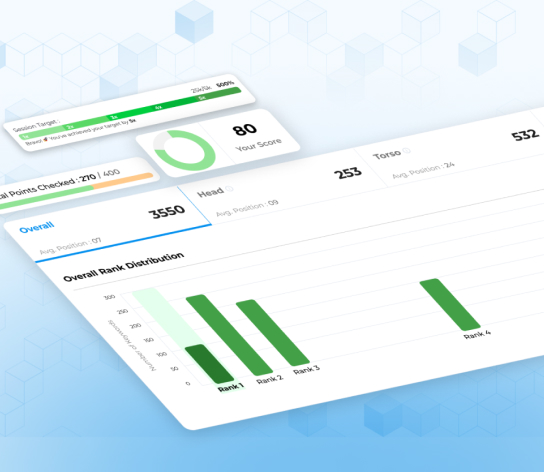What is an HTTP status code checker?
Quick and Easy Steps to Use Our HTTP Status Code Checker
Step 1: Enter your URL
To commence your journey to a clearer understanding of your website’s health, begin by entering the URL you wish to verify into the designated text field. It’s a straightforward process: simply copy and paste the full website address, ensuring it includes either the HTTP:// or HTTPs:// protocol as appropriate. Whether you’re looking to check a single URL or multiple ones at once, our HTTP Status Code Checker stands ready to facilitate your needs. Just input the address, and you’re set for the next step.
Step 2: Receive Real-Time Results
Upon submitting your URLs, our HTTP Status Code Checker swings into action. With a single click on the “Check” button, the magic begins: the tool runs in real-time, processing the input and swiftly providing you with a comprehensive report. It’s a matter of seconds before you can observe the status codes for each URL, information that sheds light on the health and accessibility of your web pages. No need to wait or refresh — the results unfold right before your eyes, preparing you to take any necessary action instantly.
How to Read Your HTTPS Status Report?
Understanding your HTTPS status report is critical for diagnosing and rectifying any issues your website might face. Upon generating the status report, you’ll be presented with details often including HTTP status codes, server response time, and header information.
HTTP status codes are categorized into series: 2xx indicates success, 3xx denotes redirects, 4xx signals client errors, and 5xx are server errors. It’s important to recognize that codes like 404 mean a page is not found, whereas 200 signifies successful retrieval.
Server response time can reveal how quickly your server is responding to requests—a key factor in user experience and search engine ranking.
Lastly, HTTP header information unveils backend communication processes between browsers and servers. It provides the type of server, content type, cache control policies, and more—which are vital for optimizing website performance.
What Infidigit’s HTTP Status Tool Checks?
HTTP status of URL
When you utilize our HTTP Status Code Checker, the foundational piece of information you’ll receive is the HTTP status of the URL you’re investigating. This status tells you whether a web page is functioning correctly or encountering issues. For instance, a status code of 200 means everything is operating smoothly — the URL is accessible, and the requested resource is successfully delivered. On the other hand, the presence of a 404 indicates a problem; the requested page cannot be found, signifying a potential dead link or a removed page. It’s critical to regularly monitor these statuses because they can have a significant impact on user experience and search engine optimization.
HTTP header code
The HTTP header code, a component of the HTTP status report, provides a wealth of diagnostic information. Beyond the HTTP status code, the header includes metadata such as the server type, content type, caching policies, and set cookies, amongst others. This metadata assists in understanding how web pages are served and processed. For instance, cache-control directives in the header can inform browsers how to handle caching, which directly affects page load times and efficiency. By reviewing the HTTP header code with our tool, you’ll gain deeper insight into the server behavior and configurations that impact the functionality and performance of your website.
Host
The host essentially indicates the domain serving the requested URL, which is crucial to verify that your content is being served from the expected source. If discrepancies are found between the host and the domain, it could suggest misconfigurations or potential security concerns that need to be addressed. Recognizing the correct hostname ensures that traffic is directed appropriately and helps maintain the security and reliability of your web presence.
The Importance of Regular URL Checks
Stay Ahead with Consistent HTTP status Monitoring
Consistent HTTP status monitoring is essential for maintaining a healthy and thriving website. Regular checks alert us to the presence of any issues, such as broken links, page not found errors, or server problems before they negatively impact the user experience or SEO rankings. With timely detection and resolution of these problems, we can ensure uninterrupted website availability and performance, contributing to better user engagement and potentially higher search engine visibility. Staying proactive with HTTP status monitoring is not just about fixing problems; it’s about offering a seamless, quality experience to every visitor and maintaining the integrity of your online domain.
Reduce Downtime and Maintain Optimal Performance
Through vigilant monitoring of HTTP status codes, we take an important step toward minimizing downtime. By being informed of error codes as soon as they occur, we can quickly pinpoint and address issues, reducing the time our website is inaccessible or performing sub-optimally. This proactive approach not only enhances the user experience by ensuring they can always access the content they need, but it also aids in maintaining our website’s SEO standing, as frequent downtimes can negatively impact search engine rankings. In essence, our HTTP status checker becomes a crucial ally in ensuring our digital presence is robust, reliable, and consistently delivers optimal performance.
Frequently Asked Questions
Free SEO Tools
How useful was this post?
5 / 5. 3








